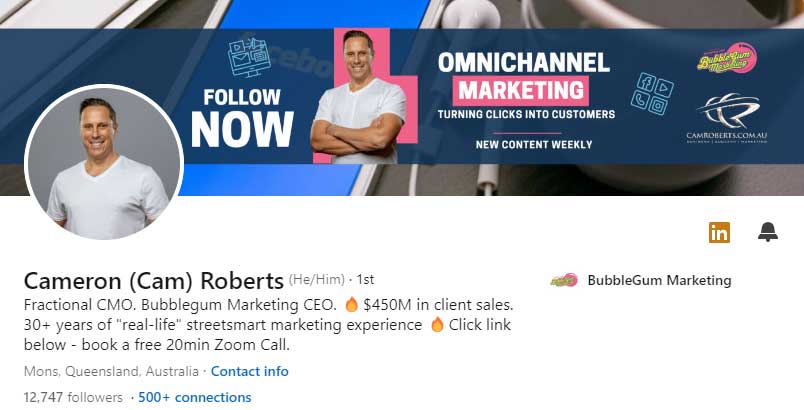Sales Funnel vs. Marketing Funnel: What’s the Difference?
By Cameron Roberts – Founder & CEO of Bubblegum Marketing,
Posted On February 19, 2024
In the world of turning curious folks into happy customers, it’s important to know how sales and marketing funnels work together. Imagine two connected funnels: one spreading the word about your brand and getting people interested, while the other gently guides them towards making a purchase. This teamwork is crucial for keeping a business growing. But for many, it can be hard to tell these funnels apart.
This blog is here to help. We’ll explain the different goals, audiences, and tasks of each funnel, while also showing how they work together. Whether you’re a pro marketer or just starting out, this blog has tips to improve how customers go through your business.
Stick around till the end to learn the differences between sales and marketing funnels, find ways to improve, and make your business even better.
What is a Sales Funnel?
A sales funnel is like a roadmap that helps businesses turn interested people into happy customers. Each stage of the funnel is important because it brings businesses closer to achieving their goal of gaining happy customers. Typically, a sales funnel has four key stages, and here’s what they involve. It’s a step-by-step process where we guide people from just looking at our product to actually buying it. Here’s how it works:
- Figuring out who’s really interested: When it comes to sales, not every lead is the same. At the start of the process, it’s important to identify who is genuinely interested and has a real intention to buy, versus those who are just browsing or exploring their options. Not everyone who shows interest will buy. So, we use things like forms and demos to find out who’s serious about buying and who’s just browsing.
- Showing why our product is great: Once we find interested folks, we show them why our product is awesome. We do this by giving them personalized presentations and demos that highlight how our product solves their problems. It’s time to showcase the true value proposition of your product or service.
- Talking about the details: When people are interested, we discuss things like price and terms to make sure everyone’s happy. It’s important to listen to what they need and find solutions that work for both of us.
- Making it official: Once we agree on everything, it’s time to seal the deal! We finalize the paperwork and make sure everything’s set for them to become our customer.
But it doesn’t end there! We want to keep our customers happy even after they buy. So, we follow up with them, give them personalized recommendations, and offer loyalty programs to make sure they keep coming back.
What is a Marketing Funnel?
A marketing funnel is like a roadmap for businesses to turn potential customers into loyal fans. It’s a step-by-step process where you share your brand’s message, nurture interest, and ultimately build customer loyalty. Each stage of the funnel represents a planned step in the customer journey, guiding people from first discovering your brand to becoming happy customers. Here’s how it works:
Awareness
When you want to build your brand, the first step is to get the attention of your target audience. You can do this in many ways, such as by creating engaging social media content, writing informative blog posts, using targeted SEO strategies, or running eye-catching paid advertising campaigns. The goal is to introduce your brand to a large audience and make it recognisable.
Interest
Now that you’ve grabbed their attention, it’s time to pique their curiosity. This stage involves offering valuable content that dives deeper into your brand’s offerings, showcasing solutions to their pain points, and establishing your expertise. Engaging email campaigns, informative webinars, and downloadable resources are powerful tools at this stage.
Desire
When you introduce your brand and get people interested, it’s time to make them want it even more. This is where you show how your product or service solves problems and meets needs. To do this, you can use demos, case studies, and testimonials. These will help build trust and convince people that your offering is the right choice.
Action
When trying to get people to take action, it’s important to make things easy for them. This means offering good deals, clear instructions, and a simple process. The goal is to make it easy for people to buy from you, and to make sure they have a good experience.
But it’s not enough to just get people to buy from you once. You need to keep them interested in your brand so they’ll come back again and again. This means offering good content, loyalty programs, and other ways to keep them engaged. By doing this, you can turn one-time buyers into repeat customers who are excited about your brand and recommend it to others.

Key Differences Between the Two Funnels
While both funnels guide individuals towards conversion, their distinct goals, target audiences, and activities set them apart. Here’s a table summarising the key differences:
| Feature | Marketing Funnel | Sales Funnel |
| Goal | Generate leads, raise brand awareness, nurture general interest | Convert leads into paying customers, close deals, build long-term relationships |
| Target Audience | Broader audience, potential customers | Qualified leads, individuals who have expressed interest |
| Activities | Content creation, social media marketing, SEO, lead generation campaigns, webinars, ebooks, blog posts | Email marketing, personalised offers, demos, consultations, negotiations, presentations |
| Metrics | Website traffic, lead generation, engagement metrics, social media following growth | Conversion rates, sales closure rates, average order value, customer lifetime value |
| Perspective | Broader view, attracting anyone who might be interested | Focused view, tailoring offerings to specific needs |
| Depth of Personalisation | Lower level of personalisation, broader content for general audience | Higher level of personalisation, addressing specific needs and concerns |
| Analogy | Casting a fishing net, catching a large number of fish (potential leads) | Selecting the desired fish from the net, individually examining and preparing them for consumption (conversion) |
This table provides a quick overview, but let’s delve deeper into some of the key distinctions:
- Goals: The marketing funnel focuses on attracting and informing, while the sales funnel focuses on convincing and closing.
- Target Audience: The marketing funnel targets a broader audience, building awareness and interest. The sales funnel targets qualified leads, ready to move towards conversion.
- Activities: Marketing activities revolve around content creation and lead generation, while sales activities involve personalised interactions and deal-closing strategies.
- Metrics: Marketing success is measured by engagement and lead generation, while sales success is measured by conversion rates and sales figures.
By understanding these distinctions, you can effectively leverage both funnels to attract the right audience, nurture their interest, and ultimately, convert them into loyal customers.
Benefits of Aligning Both Funnels
Imagine trying to row a boat with one team pulling forward and the other pushing back. Not exactly smooth sailing, right? That’s what happens when your marketing and sales funnels operate in silos. But fear not! Aligning these two forces unlocks a treasure chest of benefits:
- Smoother Customer Journey: No more confusing messages or dead ends. Your leads seamlessly transition from brand awareness to personalised offers, creating a delightful journey towards conversion.
- Better Leads, Fewer Headaches: Stop wasting time on unqualified prospects. With shared criteria, your sales team gets laser-focused on leads actually ready to buy.
- Speak the Same Language: Forget mixed messages! Unified messaging across both funnels builds trust and drives home your value proposition, boosting conversion rates.
- Data Duo = Explosive Growth: Marketing unlocks customer insights for sales, while sales data helps marketing refine targeting and content. Sharing is caring, and it means higher ROI!
- Teamwork Makes the Dream Work: Collaboration fosters shared goals, communication, and a deeper understanding of your customers. Together, you’re unstoppable!
Before diving into the specifics, it’s essential to understand how to become a successful entrepreneur. It’s highlighted that working together across different parts of your business is really important. This helps your business grow and keeps your customers happy. Aligning your funnels isn’t just about efficiency; it’s about creating a cohesive customer experience that leads to conversions and happy customers. So ditch the silos, embrace teamwork, and watch your business sail towards success! In “How to Become a Successful Entrepreneur,”
Which Funnel Type Do You Need?
Do you feel lost in the funnel forest? Don’t worry, choosing the right path is easy. This quick guide will help you decide. But keep in mind that both marketing and sales funnels are essential for your business journey.
Starting Out:
- Focus: Marketing Funnel. Your mission? Build brand awareness and attract potential customers with awesome content. Think of it as planting the seeds!
Growing Steadily:
- Focus: Sales Funnel. Time to convert those interested seeds into paying customers! Personalised offers, demos, and building trust are your watering can.
Established Player:
- Focus: Both Funnels (equal love!). Make sure your brand stays strong while also attracting new customers and keeping your current ones happy. This is like giving your business the right dose of sunshine and fertiliser to help it flourish.
Remember:
- Track your results: Watch key metrics like website traffic and conversion rates to see what’s working for each funnel.
- Teamwork makes the dream work: Marketing and Sales should be BFFs, sharing data and working together to nurture leads seamlessly.
- Adapt and grow: As your business blossoms, adjust your focus based on what’s working best, always remembering that both funnels are crucial for sustainable growth.
With a little thought and this handy guide, you’ll choose the right balance for your current stage and watch your business bloom!
In Conclusion
Choosing between a marketing funnel and a sales funnel can be a daunting task, but it’s important to remember that they both play a crucial role in your business’s growth. By tracking your results, fostering teamwork between marketing and sales, and adapting your focus as your business grows, you can find the right balance between the two funnels to ensure sustainable growth.
With the tips provided in this guide, you’re well on your way to making an informed decision and watching your business bloom. However, if you still need professional assistance, we are always ready to help our customer turn around the fortune of their struggling businesses. We at BubbleGum Marketing take pride in designing a sales funnel and marketing funnel that sells. Call us at +61 1300727983 today!
Get personalized advice on leveraging both effectively. Schedule a quick strategy call and start building a high-converting funnel today!
WANT TO BE OUR NEXT SUCCESS STORY?
Book a Free Consult
Schedule a 15-minute Free Consultation via Zoom meetings with our Director, Cam Roberts by clicking the button below now:
Recent Articles
- The Concept of Intent-First Funnels for Smarter Conversions
- Automated Funnel Strategies for 2025: What Still Works
- 5 Common Funnel Mistakes That Are Killing Your Conversions
- How AI Is Revolutionising CRM: What Every Marketer Needs to Know
- How Fractional CMO Services from a Marketing Agency Help You Grow Without Full-Time Costs
- How a Fractional CMO Can Transform Your Business Strategy
- How to Find the Perfect Target Audience for Facebook Ads
- How to Scale Facebook Ads Without Increasing Costs
- How E-commerce Brands Can Use Facebook Ads to Boost Sales
- How to Create a High-Converting Facebook Ad Campaign
Request A Quote
Request A Quote for your next Website or Funnel Project below:










































